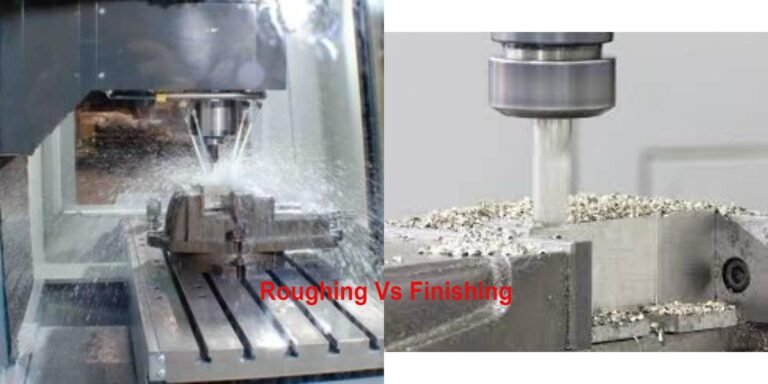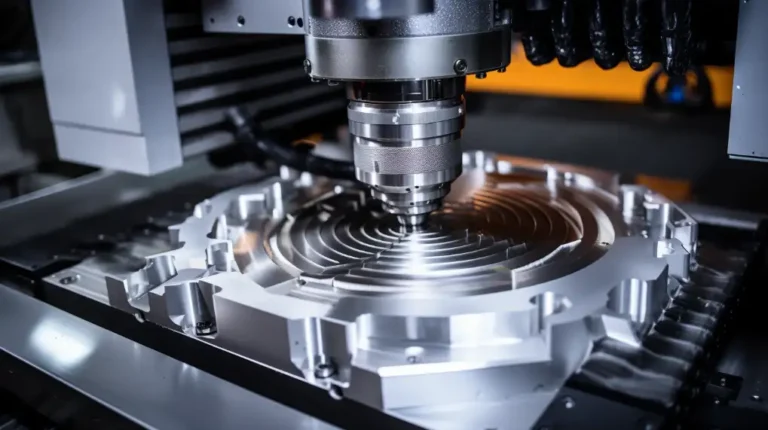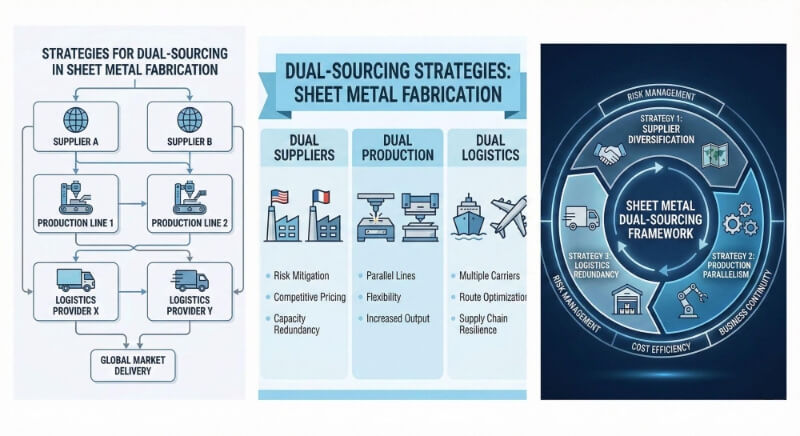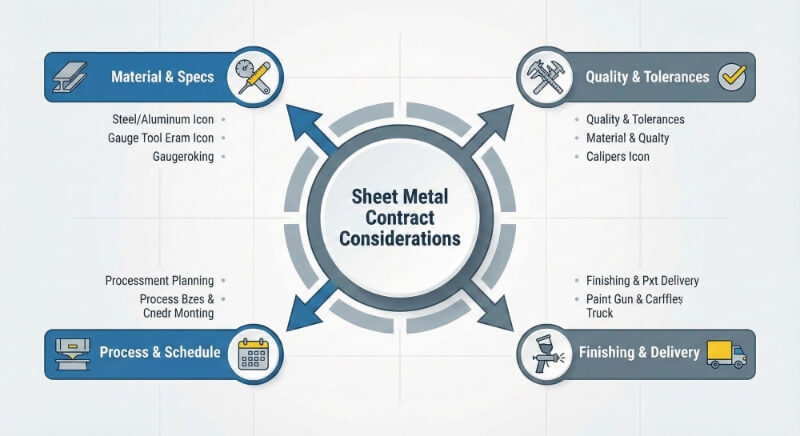We often hear about roughing and finishing in machining, but what exactly sets them apart? In this post, I’ll break down the differences between these two critical stages of the machining process.
Roughing is the first phase of machining, where the main goal is to remove large amounts of material from a workpiece as quickly as possible. This stage is not about achieving a perfect finish or exact dimensions but rapidly shaping the workpiece to a rough approximation of the final form. On the other hand, finishing is the subsequent phase, where the focus shifts to achieving precise dimensions, tighter tolerances, and a smoother surface finish.
Stay tuned as we delve deeper into each stage, exploring their unique roles and impacts on the final product.

What is Roughing in Machining?
Definition of Roughing
Roughing in machining is the process of removing significant portions of material from a workpiece. It’s the initial stage of the machining process, where speed and efficiency are prioritized over precision.
Primary Objectives of Roughing
The main objectives of roughing are to shape the workpiece to the desired final form quickly and prepare it for the finishing stage. This process is designed to be fast and cost-effective, reducing the workpiece to a form that requires minimal material removal during finishing.
Essential Tools and Equipment Used in Roughing
We often use tools that can handle high material removal rates in roughing. These include coarse-pitched milling cutters, large-diameter drills, and roughing end mills. Equipment robust enough to withstand the stresses of high-speed material removal is essential.
Material Considerations for Roughing
Choosing the suitable material for the tool and the workpiece is crucial in roughing. Tools are generally made from high-speed steel or carbides to withstand harsh conditions, while the workpiece materials must be compatible with rapid material removal without compromising structural integrity.
Techniques and Strategies in Roughing
Roughing strategies are centered around maximizing the material removal rate while minimizing wear on tools and avoiding damage to the workpiece.
High-Speed vs. Low-Speed Roughing
High-speed roughing involves using high spindle speeds and feed rates to remove material quickly, often employed in softer materials. Low-speed roughing, used for more complex materials, focuses on managing heat and tool wear.
Depth of Cut and Feed Rate Settings
Setting the correct depth of cut and feed rate is critical in roughing. A deeper cut can remove more material per pass but may increase tool wear and energy consumption. Balancing these factors is critical to optimizing the roughing process.
What is Finishing in Machining?
Definition of Finishing
Finishing in machining is the final stage of the manufacturing process, where the focus shifts to achieving precise dimensions, tighter tolerances, and a high-quality surface finish. It involves removing a smaller amount of material compared to roughing.
Primary Objectives of Finishing
The primary goals of finishing are to enhance the accuracy of the workpiece, achieve the required dimensions, and obtain a smooth surface finish that meets specific standards. This stage is critical for the functionality and aesthetics of the part.
Essential Tools and Equipment Used in Finishing
Finishing uses tools that are designed for precision. This includes fine-pitched end mills, precision grinding wheels, and polishing tools. These tools are typically made from ceramic, diamond, or fine-grained carbides to ensure a high-quality finish.
Material Considerations for Finishing
The materials used in the workpiece during finishing must achieve a good surface finish and maintain dimensional accuracy under finer machining operations. This often requires materials with a stable microstructure and good machinability.
Techniques and Strategies for Finishing
Finishing techniques are focused on precision and minimizing defects. This includes controlling vibration, using coolant effectively, and selecting the right cutting conditions.
Precision Finishing Techniques
Techniques such as jig grinding, lapping, and honing are commonly used for precision finishing. These methods allow for achieving highly tight tolerances and very smooth surface finishes, essential for critical components in aerospace and medical applications.
Optimal Feed Rate and Speed Settings for Finishing
Setting optimal feed rates and speeds in finishing is crucial for the quality of the surface finish and the tool’s life. Lower speeds and finer feed rates are typically used to minimize tool wear and avoid surface damage, ensuring the finished part meets all specifications.

Roughing VS Finishing: Comparing
Differences in Purpose and Goals
Roughing and finishing serve distinct purposes in the machining process. Roughing is all about rapidly reducing a workpiece to a rough shape, focusing on speed and efficiency rather than precision. Finishing, however, aims to refine the workpiece to precise dimensions and a smooth surface, prioritizing accuracy and quality over speed.
Comparison of Tool Types and Usage
The tools used in roughing are typically more robust and designed to handle high material removal rates, such as roughing end mills and coarse-pitched cutters. Finishing tools, like fine-grained carbide end mills and polishing wheels, are designed for precision and fine detailing. These differences reflect the distinct objectives of each stage—bulk material removal vs. precision enhancement.
Material Removal Rates: Roughing vs. Finishing
Material removal rates differ significantly between roughing and finishing. Roughing involves quickly removing large amounts of material to shape the workpiece, achieving high removal rates. Finishing, on the other hand, removes material much more slowly, focusing on achieving the final dimensions and surface quality, which requires more precise and controlled operations.
Surface Quality and Tolerances
The surface quality and tolerances achievable in roughing and finishing also vary greatly. Roughing only sometimes achieves acceptable tolerances or surface finishes, as its primary goal is to remove material quickly. Finishing processes are designed to achieve tight tolerances and high-quality finishes, essential for the final use of the part in its intended application.
Cost Implications and Efficiency
The cost implications and efficiency of roughing and finishing are closely tied to their objectives. Roughing is generally more cost-effective regarding material removal per unit of time, making it efficient in terms of throughput. Finishing, while slower and often more expensive due to the need for precision and specialized tools, adds significant value by ensuring that the part meets all specifications and functional requirements.
Roughing Vs Finishing In Machining: Quick Comparison
Here’s a quick comparison table based on the differences between roughing and finishing in machining:
| Aspect | Roughing | Finishing |
|---|---|---|
| Purpose and Goals | Rapid material removal to shape the workpiece. | Achieve precise dimensions and smooth surface. |
| Tools Used | Robust, designed for high material removal rates. | Precision tools for fine detailing and finishing. |
| Material Removal Rates | High, focuses on speed and efficiency. | Low, focuses on precision and control. |
| Surface Quality and Tolerances | Lower surface quality and looser tolerances. | High surface quality and tight tolerances. |
| Cost and Efficiency | More cost-effective for bulk material removal. | More expensive due to precision requirements, adds significant value. |
Considerations For Roughing In Machining
Here are some considerations for roughing in machining:
Machining Parameters
- Feed Rate: Higher feed rates are expected to maximize material removal.
- Spindle Speed: Adjusted according to the material to optimize cutting efficiency.
- Depth of Cut: Generally deeper to remove more material per pass.
Type of Machine Tool and Control Software
- Machine Rigidity: Requires robust machine tools capable of handling large cutting forces.
- Control Software: Advanced software that can handle dynamic changes in load and speed to prevent tool damage.
Heat and Cutting Fluid
- Heat Management: Effective heat dissipation is crucial due to the high heat generated in roughing.
- Cutting Fluids: Use appropriate cutting fluids to reduce friction and cool the tool and workpiece, prolonging tool life and improving the cut quality.
Considerations For Finishing In Machining
Here are some considerations for finishing in machining:
Dimensional Accuracy
- Precision: Achieving exact dimensions requires careful calibration of tools and machines.
- Tolerances: Tight tolerances are necessary to ensure the part meets specific functional and assembly requirements.
The Part’s Application
- Surface Finish: Requires a high-quality surface finish, especially for parts with aesthetic or functional surfaces.
- Functionality: The finished part must function appropriately in its intended mechanical or operational environment, influencing finishing techniques.
Cost
- Tool Wear: Finishing often requires more expensive, precision tools that wear down more slowly but cost more upfront.
- Operation Time: Finishing processes can be time-consuming, impacting production timelines and overall costs.
Conclusion
Understanding the different roles of roughing and finishing can improve cost-effectiveness and product quality. Roughing uses robust tools to remove material and efficiently shape the workpiece quickly. In contrast, finishing focuses on accuracy, utilizing specialized tools and techniques to achieve tight tolerances and smooth surfaces.
Manufacturers must weigh the part’s dimensional needs and surface quality against time and tool wear costs. Manufacturers can produce high-quality, cost-effective parts by strategically managing roughing and finishing.
Do you need a reliable sheet metal parts manufacturer? Shengen is the place to go. We specialize in sheet metal laser cutting, bending, surface finish, and CNC Machining. Reach out to Shengen Today and seek help from professionals!
FAQs
How can one optimize tool life in both roughing and finishing?
Use durable materials like high-speed steel or carbide with protective coatings such as TiN to optimize tool life. Adjust machining parameters like feed rate and spindle speed, and use effective cooling and lubrication to reduce wear and manage heat.
What are the latest technological innovations impacting roughing and finishing?
Recent innovations include advanced CNC technology for greater precision, high-performance cutting tools with improved materials and coatings, and the integration of automation and AI for adaptive control of machining parameters.
How do material properties affect the choice between roughing and finishing?
Material properties like hardness and machinability dictate the machining approach. Hard materials may require specific finishing techniques to achieve desired outcomes, while materials with poor machinability might need gentler handling to maintain quality during roughing and finishing.
More Resources:
Optimizing Tool Life – Source: Kyocera
Surface Finish Standards in Machining – Source: Elemetgroup
Machining Heat Management – Source: MSC
Hey, I'm Kevin Lee

For the past 10 years, I’ve been immersed in various forms of sheet metal fabrication, sharing cool insights here from my experiences across diverse workshops.
Get in touch

Kevin Lee
I have over ten years of professional experience in sheet metal fabrication, specializing in laser cutting, bending, welding, and surface treatment techniques. As the Technical Director at Shengen, I am committed to solving complex manufacturing challenges and driving innovation and quality in each project.




